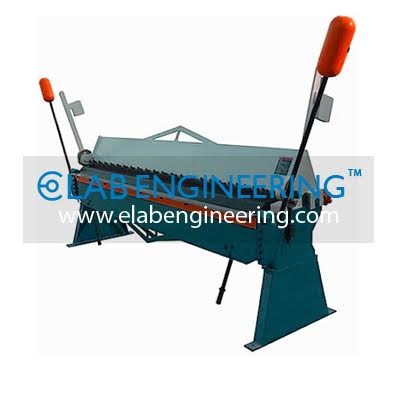
Description and Specification for Lab Tenders
Universal Bending Machine.
Universal Combination bending brakes represent a modern departure from
the old conventional hand brake design. They are not limited to straight
bending and box and pan work alone, but will accommodate inside
bending, radius forming many other intricate forming operations with
special attachments. They are limited in versatility only by the
operator’s ingenuity.
These brakes will from a 1” flange over the entire length in their rated capacity.
Heavy duty springs reduce clamping effort and adjustable counterweights reduce bending effort.
The upper beam may be moved directly to the read either 6 or8
inches to accommodate box fingers and special forming attachments. The
normal maximum opening between the upper beam and the lower beam is
1.3/4” and may be increased to 4” to accept box and pan fingers.
When the apron angle iron work support is removed, brake capacity is reduced by 2 guages.
When the apron angle iron work support and apron filler plates are
removed, brake capacity is reduced by 4 guages. When both are removed,
¼” reverse bends may be made except on 8 foot and 10 foot, 12 foot guage
brakes only 3/8” reverse bends may be made. When bending stainless
steel brake capacity is reduced 4 guages for both straight and finger
bending.
|
Showing section of machine with standard bar and fingers. Note position of folding axis which is constant, no matter what bend is being formed. Metal is in position after a simple right angle bend. |
|
For this operation, Making small radius bends, the folding beam is lowered in the side arms and the metal clamped in the normal way. When folding beam is raised, the gap between the nose of the folding blade and the face of the folding beam allows a rounded bend to be made. |
|
Showing how small return bends can be formed using a specially stepped bar. Such a bar is useful for Narrow return bends can also be formed by substituting the narrow auxiliary blade supplied, for the angle blade, giving a smaller thickness to the folding beam. |
|
Brake will form a one inch flange at rated capacity its entire length with the Apron Filler Plate (101) and Apron Work Support (104) in Place. (See fig. 3) Removal of Apron Work support (104), reduces brake capacity by 2 gauges. Removal of both Apron Work support (104) and the Apron Filler Plate (101) reduces brake capacity by 4 gauges. |
| Minimum Reverse Bends : Removal of both Apron Work support and the Apron Filler Plate permits 1/4" reverse bends to be made on all brakes except Modeis 8ft. x 10ft. On these two models the minimum reverse bend is 3/8 (See Fig. 4) |
| To Flatten Seam With Apron : |
Caution : Do Not Form Wire, Nails, Rope or Pipe in These Brakes